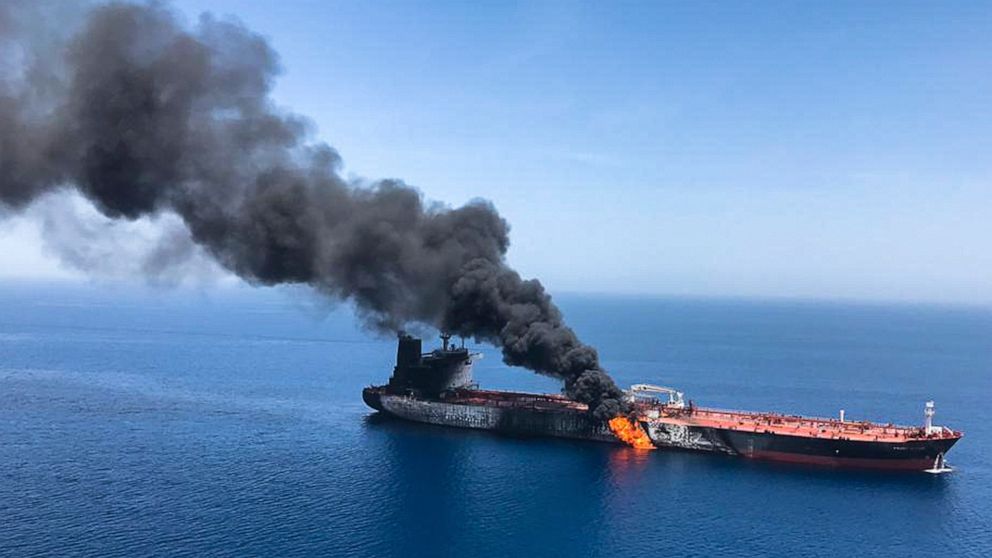Two tankers attacked in Gulf of Oman, US not ruling out Iran is responsible

Two commercial tanker ships were hit by apparent attacks on Thursday while sailing in international waters in the Gulf of Oman, and while a U.S. official said that it was too soon to make a determination if Iran was responsible, the official said “we’re not ruling anything out at this time.”
Interested in Iran?
Add Iran as an interest to stay up to date on the latest Iran news, video, and analysis from ABC News.
One ship reportedly was on fire and the other suffered damage and 21 mariners from one of the ships were taken aboard a U.S. Navy destroyer after having abandoned ship. The 23 mariners from the other vessel were reportedly taken to Iran.
The attacks come at a time of heightened tensions between the United States and Iran after an American aircraft carrier was deployed to the Middle East in what the U.S. said was an effort to deter possible Iranian attacks against U.S. forces or interests in the region.
U.S. officials have publicly blamed Iran for explosive sabotage attacks in mid-May against four commercial vessels off the coast of the United Arab Emirates.
“We’re not pointing to Iran, but we’re not ruling anything out at this time,” a U.S. official said when asked if Iran was responsible for Thursday’s attacks.
“We are aware of the reported attack on shipping vessels in the Gulf of Oman,” said Cmdr. Josh Frey, a spokesman for the U.S. Navy’s Fifth Fleet. “U.S. Naval Forces in the region received two separate distress calls at 6:12 a.m. local (Bahrain) time and a second one at 7:00 a.m. U.S. Navy ships are in the area and are rendering assistance.”
The MT Kokuka Courageous was first to issue a distress call and its crew of 21 mariners abandoned ship. At the time of the attack the ship had been transiting through the Gulf of Oman in international waters, close to Iran.
A nearby Dutch tug picked up the mariners and then transferred them to the U.S. Navy destroyer USS Bainbridge that had been in the vicinity and also responded to the distress call, according to a U.S. official. The mariners are currently aboard the Bainbridge being cared for as the destroyer remains at that location, said the official.
About 45 minutes later distress calls were received from the MT Front Altair, a commercial ship that was a significant distance away from the Kokuka Courageous said the official. The 23 mariners aboard that ship also abandoned ship.
The Seoul-based Hyundai Merchant Marine Co. confirmed in a statement that its ship the Hyundai Dubai had rescued the 23 mariners from the MT Front Altair and then turned them over to an Iranian rescue boat.
According to the Associated Press, both ships were bound for Japan when they were attacked, the Front Altair was carrying a cargo of naptha, a flammable hydrocarbon and the Kokuka Courageous was carrying a cargo of methanol.
Photos showed the MT Front Altair aflame with smoke billowing from the side of the ship.
“The President has been briefed on the attack on ships in the Gulf of Oman,” said White House press secretary Sarah Sanders. “The U.S. Government is providing assistance and will continue to assess the situation.”
The suspected attacks come almost a month after four commercial freighters were damaged by explosive sabotage attacks off the coast of the United Arab Emirates. The United States has publicly blamed Iran for placing magnetic explosives to the ships’ hulls, subsequent explosions left 5 to 10 foot gashes in the ships along their waterline.
Prior to that attack there had been sightings of about 20 Iranian fast attack vessels moving through the Strait of Hormuz to the general area where those attacks occurred, said the U.S. official.
That attack came nearly a week after the United States had accelerated the deployment to the Middle East of the USS Abraham Lincoln aircraft carrier strike group and sent B-52 bombers to deter possible Iranian attacks to U.S. forces and interests in the region.
Gen. Kenneth McKenzie, the commander of U.S. Central Command, told reporters that the deployment had led Iran to “step back and recalculate” though the U.S. still saw “possible imminent threats.”
Javad Zarif, Iran’s Foreign Minister tweeted that the timing of attack on the tankers was suspicious because it occurred during a meeting between Japanese Prime Minister Shinzo Abe and Ayatollah Khameini, Iran’s supreme leader.
“Suspicious doesn’t begin to describe what likely transpired this morning,” he tweeted.
Earlier, Khameini had said during his meeting with Abe that that while Tehran doesn’t want an atomic bomb, “America could not do anything” to stop Iran if it did.

